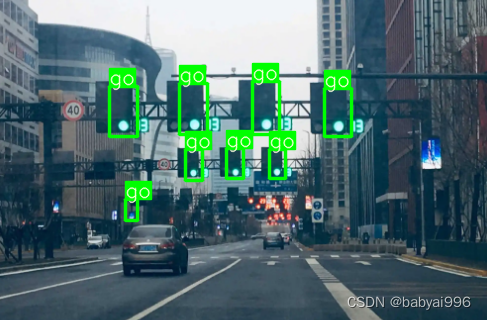python交通信号灯检测yolov5交通信号灯识别,红绿灯检测,左转右转识别
交通信号灯的检测与识别是无人驾驶与辅助驾驶必不可少的一部分,其识别精度直接关乎智能驾驶的安全。一般而言,在实际的道路场景中采集的交通信号灯图像具有复杂的背景,且感兴趣的信号灯区域只占很少的一部分,如下图所示。针对这些难点,国内外的众多研究者提出了相应的解决方案。
import argparse
from models import * # set ONNX_EXPORT in models.py
from utils.datasets import *
from utils.utils import *
def detect(save_img=False):
imgsz = (320, 192) if ONNX_EXPORT else opt.img_size # (320, 192) or (416, 256) or (608, 352) for (height, width)
out, source, weights, half, view_img, save_txt = opt.output, opt.source, opt.weights, opt.half, opt.view_img, opt.save_txt
webcam = source == '0' or source.startswith('rtsp') or source.startswith('http') or source.endswith('.txt')
# Initialize
device = torch_utils.select_device(device='cpu' if ONNX_EXPORT else opt.device)
# if os.path.exists(out):
# shutil.rmtree(out) # delete output folder
os.makedirs(out, exist_ok=True) # make new output folder
# Initialize model
model = Darknet(opt.cfg, imgsz)
# Load weights
attempt_download(weights)
if weights.endswith('.pt'): # pytorch format
model.load_state_dict(torch.load(weights, map_location=device)['model'])
else: # darknet format
load_darknet_weights(model, weights)
# Second-stage classifier
classify = False
if classify:
modelc = torch_utils.load_classifier(name='resnet101', n=2) # initialize
modelc.load_state_dict(torch.load('weights/resnet101.pt', map_location=device)['model']) # load weights
modelc.to(device).eval()
# Eval mode
model.to(device).eval()
# Fuse Conv2d + BatchNorm2d layers
# model.fuse()
# Export mode
if ONNX_EXPORT:
model.fuse()
img = torch.zeros((1, 3) + imgsz) # (1, 3, 320, 192)
f = opt.weights.replace(opt.weights.split('.')[-1], 'onnx') # *.onnx filename
torch.onnx.export(model, img, f, verbose=False, opset_version=11,
input_names=['images'], output_names=['classes', 'boxes'])
# Validate exported model
import onnx
model = onnx.load(f) # Load the ONNX model
onnx.checker.check_model(model) # Check that the IR is well formed
print(onnx.helper.printable_graph(model.graph)) # Print a human readable representation of the graph
return
# Half precision
half = half and device.type != 'cpu' # half precision only supported on CUDA
if half:
model.half()
# Set Dataloader
vid_path, vid_writer = None, None
if webcam:
view_img = True
torch.backends.cudnn.benchmark = True # set True to speed up constant image size inference
dataset = LoadStreams(source, img_size=imgsz)
else:
save_img = True
dataset = LoadImages(source, img_size=imgsz)
# Get names and colors
names = load_classes(opt.names)
# colors = [[random.randint(0, 255) for _ in range(3)] for _ in range(len(names))]
colors = [(0, 255, 0), (0, 0, 255), (0, 0, 155), (0, 200, 200), (29, 118, 255), (0 , 118, 255)]
# Run inference
t0 = time.time()
img = torch.zeros((1, 3, imgsz, imgsz), device=device) # init img
_ = model(img.half() if half else img.float()) if device.type != 'cpu' else None # run once
for path, img, im0s, vid_cap, frame, nframes in dataset:
img = torch.from_numpy(img).to(device)
img = img.half() if half else img.float() # uint8 to fp16/32
img /= 255.0 # 0 - 255 to 0.0 - 1.0
if img.ndimension() == 3:
img = img.unsqueeze(0)
# Inference
t1 = torch_utils.time_synchronized()
pred = model(img, augment=opt.augment)[0]
t2 = torch_utils.time_synchronized()
# to float
if half:
pred = pred.float()
# Apply NMS
pred = non_max_suppression(pred, opt.conf_thres, opt.iou_thres,
multi_label=False, classes=opt.classes, agnostic=opt.agnostic_nms)
# Apply Classifier
if classify:
pred = apply_classifier(pred, modelc, img, im0s)
# Process detections
for i, det in enumerate(pred): # detections for image i
if webcam: # batch_size >= 1
p, s, im0 = path[i], '%g: ' % i, im0s[i].copy()
else:
p, s, im0 = path, '', im0s
save_path = str(Path(out) / Path(p).name)
print(save_path)
s += '%gx%g ' % img.shape[2:] # print string
gn = torch.tensor(im0.shape)[[1, 0, 1, 0]] # normalization gain whwh
if det is not None and len(det):
# Rescale boxes from imgsz to im0 size
det[:, :4] = scale_coords(img.shape[2:], det[:, :4], im0.shape).round()
# Print results
for c in det[:, -1].unique():
n = (det[:, -1] == c).sum() # detections per class
s += '%g %ss, ' % (n, names[int(c)]) # add to string
# Write results
for *xyxy, conf, cls in det:
if save_txt: # Write to file
xywh = (xyxy2xywh(torch.tensor(xyxy).view(1, 4)) / gn).view(-1).tolist() # normalized xywh
with open(save_path[:save_path.rfind('.')] + '.txt', 'a') as file:
file.write(('%g ' * 5 + '\n') % (cls, *xywh)) # label format
if save_img or view_img: # Add bbox to image
# label = '%s %.2f' % (names[int(cls)], conf)
label = '%s' % (names[int(cls)])
plot_one_box(xyxy, im0, label=label, color=colors[int(cls)])
# Print time (inference + NMS)
print('%sDone. (%.3fs)' % (s, t2 - t1))
python交通信号灯检测yolov5交通信号灯识别,红绿灯检测,左转右转识别